
Categories:
In the world of guns, magazine selection plays a crucial role in determining a weapon’s effectiveness and reliability. When it comes to automatic weapons such as submachine guns or assault rifles, shooters often have two primary options: box magazines and drum magazines. These magazine types differ in design, capacity, and functionality, each offering distinct advantages and disadvantages that cater to specific shooting needs.
Box magazines are the traditional choice for many guns enthusiasts. As their name suggests, these magazines have a rectangular or box-shaped design. They are typically made from metal or polymer materials and consist of a spring-driven follower that pushes cartridges up into the gun’s chamber. Box magazines come in various capacities but generally hold anywhere from 10 to 100 rounds, depending on the gun model.
On the other hand, drum magazines offer shooters an alternative option with increased ammunition capacity. Unlike box magazines with their rectangular shape, drum magazines feature a cylindrical design resembling small drums – hence their name. These larger-capacity magazines can hold anywhere from 50 to several hundred rounds of ammunition, making them ideal for sustained fire or situations where reloading may not be feasible.
While both box and drum gun magazines serve the same fundamental purpose of storing and feeding ammunition into guns automatically, they differ significantly in terms of size, weight distribution on the gun when attached, reloading speed, and overall maneuverability during use.
To help you make an informed decision about which magazine type is best suited for your shooting requirements – whether it be target practice at a range or self-defense scenarios – this article will delve into the characteristics of both box and drum gun magazines. By exploring their advantages and drawbacks individually, we aim to provide you with valuable insights that will enable you to choose wisely based on your unique shooting preferences.
Box magazines have been widely used in guns for many years due to their functionality and convenience. These magazines are typically rectangular in shape and hold cartridges stacked horizontally, allowing for quick and efficient reloading. However, like any other gun component, box magazines have their own set of advantages and disadvantages.
One of the main advantages of box magazines is their high capacity. They can hold a large number of cartridges, providing shooters with an extended firing capability before needing to reload. This is particularly advantageous in situations where rapid and sustained fire is required, such as during combat or competitive shooting events. Additionally, the rectangular shape of box magazines allows them to be easily stacked or stored without taking up excessive space.
Furthermore, box magazines offer ease of use. Reloading a gun equipped with a box magazine is typically faster compared to other types of magazine systems, such as drum or tubular magazines. The straight stack design allows shooters to load cartridges into the magazine quickly and efficiently by simply sliding them in one after another.
However, despite their advantages, box magazines also come with some drawbacks. One significant disadvantage is their susceptibility to malfunctions caused by dirt or debris entering the magazine well. The open top design makes it easier for foreign objects to enter the magazine and potentially hinder its smooth operation. Regular cleaning and maintenance are essential for ensuring reliable functioning.
Another drawback lies in the bulkiness of some high-capacity box magazines. While they provide ample ammunition capacity, they can add weight and make guns less ergonomic or unbalanced during use.
In conclusion, box magazines offer numerous advantages such as high capacity and ease of use but also come with certain drawbacks related to potential malfunctions due to debris entry or increased bulkiness. Shooters must carefully consider these factors when choosing between different types of gun magazine systems based on their specific needs and preferences.
Drum magazines have gained popularity in recent years, especially in the realm of guns. These unique ammunition feeding devices offer increased capacity and firepower, but also present certain drawbacks that must be considered. Understanding the advantages and disadvantages of drum magazines is crucial for gun enthusiasts and professionals alike.
One significant advantage of drum magazines is their high capacity. Unlike traditional box magazines, which typically hold between 10 to 30 rounds depending on the gun, drum magazines can carry anywhere from 50 to several hundred rounds. This increased ammunition capacity allows for sustained fire without frequent reloads, making them particularly useful in scenarios where a large volume of fire is required.
Additionally, drum magazines often provide a more balanced weight distribution compared to box magazines. The cylindrical shape distributes the weight of the ammunition more evenly around the gun’s center axis, resulting in improved handling and reduced fatigue during extended periods of use.
However, despite their advantages, drum magazines also have several disadvantages that should not be overlooked. Firstly, their size and shape make them bulkier than traditional box magazines. This can hinder maneuverability and make it challenging to carry spare ammunition or change magazines quickly in high-pressure situations.
Another drawback is their potential for malfunctions due to complex internal mechanisms. Drum magazines are inherently more intricate than box magazines because they utilize a rotating or oscillating mechanism to feed rounds into the gun’s chamber continuously. This complexity increases the likelihood of mechanical failures such as misfeeds or jams that can significantly impact reliability.
In conclusion, drum magazines offer increased capacity and improved weight distribution compared to box magazines; however, they also come with drawbacks including bulkiness and a higher risk of malfunctions. Ultimately, choosing between these two types depends on specific needs and preferences – whether it be enhanced firepower or maneuverability – as well as considering potential trade-offs in reliability during critical situations.
When it comes to choosing the right magazine for your gun, one of the crucial factors to consider is its capacity. The magazine’s capacity determines how many rounds you can load before needing to reload, which can significantly impact your shooting experience and effectiveness in various situations. Two popular options that gun enthusiasts often debate are box magazines and drum magazines.
While both serve the same purpose of holding ammunition, they differ in terms of design and capacity. Box magazines, as the name suggests, are rectangular or square-shaped and have a straightforward design. They typically feature a spring-loaded follower that pushes rounds into the gun’s chamber as each round is fired. The capacity of box magazines varies depending on the gun type and caliber but usually ranges from 5 to 30 rounds.
This versatility allows shooters to choose a magazine size that suits their needs, whether it be for self-defense or recreational shooting. On the other hand, drum magazines boast a cylindrical shape that resembles a drum (hence their name). These unique-looking magazines utilize a winding mechanism or electric motor to feed rounds into the gun continuously. Due to their larger size and wider circumference, drum magazines can hold significantly more ammunition compared to box magazines.
Depending on the gun model and caliber, drum magazine capacities can range from 50 rounds all the way up to an impressive 100 rounds or more. While drum magazines offer higher capacities than box magazines, they come with some drawbacks as well. Their bulkier size makes them less maneuverable and may affect weapon balance when attached. Additionally, due to their complex mechanisms, loading and unloading drums can be more time-consuming than with box magazines.
In conclusion, choosing between box and drum magazines ultimately depends on personal preference and specific shooting requirements.
When it comes to choosing between box and drum magazines for your gun, one crucial factor to consider is the reloading speed they offer. Both types of magazines have their advantages and disadvantages in terms of how quickly they can be reloaded in different scenarios.
Box magazines, also known as detachable box magazines (DBMs), are the most common type of magazine found in guns. These magazines typically have a rectangular shape with a spring-loaded follower that pushes the rounds up into the gun’s chamber. Reloading a box magazine involves removing it from the gun, replacing the spent rounds with new ones, and then reinserting it back into position.
This process can be relatively quick, especially for experienced shooters who are accustomed to handling box magazines efficiently.
On the other hand, drum magazines offer a higher ammunition capacity but tend to be slower when it comes to reloading. Drum magazines feature a circular design with a spiral-shaped spring that feeds rounds into the chamber. Reloading a drum magazine requires detaching it from the gun, opening its top cover or winding mechanism, removing any remaining rounds or spent casings, loading new rounds into the drum’s compartments, closing it up again, and reattaching it to the gun.
This process takes considerably more time compared to reloading a box magazine due to its complex design.
While box magazines excel at providing faster reloads due to their simplicity and ease of use, drum magazines can hold significantly more rounds before needing reloading. Therefore, if you anticipate being in an extended firefight or require sustained firepower without frequent reloads—such as in military or defensive situations—the increased ammunition capacity provided by drum magazines may outweigh their slower reload times.
Ultimately, understanding how both types of magazine systems differ in terms of reloading speed allows shooters to make an informed decision based on their specific needs and circumstances.
When it comes to selecting the right type of magazine for guns, weight considerations play a vital role in determining the overall performance and usability. The choice between box and drum gun magazines is often influenced by factors such as weapon type, mission requirements, and personal preferences.
Box magazines are the more traditional option, typically made of metal or polymer. They offer a sturdy construction that ensures reliable feeding and durability in various conditions. One of the significant advantages of box magazines is their relatively lighter weight compared to drum magazines. This lightweight design allows for easier maneuverability during tactical operations or extended shooting sessions.
On the other hand, drum gun magazines provide high-capacity ammunition storage but tend to be bulkier and heavier than their box counterparts. These cylindrical-shaped magazines can store up to two or three times more rounds than a typical box magazine, which can be advantageous in situations where continuous firing without reloading is necessary. However, the additional weight can impact mobility and handling, especially during rapid movements or when carrying multiple spare magazines.
For military personnel or law enforcement officers engaged in combat scenarios, minimizing weight while maintaining adequate ammunition supply is crucial for optimal performance on the field. In such cases, box magazines are often preferred due to their lightweight design that allows for greater agility without compromising on firepower.
In contrast, drum gun magazines may find more utility in specific situations such as sustained suppressive fire or prolonged shooting competitions where quick reloading may not be feasible or desirable.
Ultimately, choosing between box and drum gun magazines requires careful consideration of individual needs and mission requirements. While both options have their distinct advantages and disadvantages regarding weight considerations, striking a balance between maneuverability and firepower remains paramount when making an informed decision about magazine selection for guns.
When it comes to the comparison between box and drum gun magazines, one crucial factor that demands consideration is their overall durability. A magazine’s ability to withstand wear and tear, rough handling, and adverse environmental conditions can significantly impact its reliability in critical situations. Hence, it is essential to assess which type of magazine holds up better in terms of durability.
Box magazines, also known as detachable box magazines (DBMs), have been utilized for decades across various guns platforms. These magazines are typically made from durable materials such as steel or polymer, offering a good balance between strength and weight. Box magazines’ rigid structure provides excellent resistance against impacts and bending forces, ensuring they remain functional even after accidental drops or rough handling.
Moreover, their construction allows for easy maintenance and repair when necessary.
On the other hand, drum gun magazines offer a unique design with increased ammunition capacity compared to traditional box magazines. However, this increased capacity often comes at the expense of durability. Due to their intricate construction with moving parts inside the drum mechanism, these magazines tend to be more susceptible to damage from impacts or excessive force. Additionally, their circular shape makes them more prone to deformation when dropped or subjected to pressure.
While both types of magazines can withstand regular use under normal conditions effectively, box gun magazines generally outperform drum gun magazines in terms of long-term durability and resistance against harsh treatment. Their simplicity in design contributes to enhanced ruggedness while maintaining proper functionality over time.
To conclude this assessment on magazine durability, it is evident that box gun magazines have a clear advantage over drum gun magazines due to their robust construction and ability to withstand demanding situations effectively. Gun users seeking reliable performance in various environments should consider prioritizing the use of box gun magazines for optimal longevity and functionality.
When it comes to selecting the ideal magazine for combat situations, one must consider various factors such as firepower, maneuverability, and reliability. Two popular choices are box magazines and drum magazines, each with its own set of advantages and disadvantages.
Box magazines offer several benefits that make them a preferred choice for many combat scenarios. Their compact size allows for easy handling and maneuverability in tight spaces, making them ideal for urban warfare or close-quarter battles. Additionally, box magazines can be quickly reloaded with fresh ammunition, minimizing downtime during engagements. Their design also ensures reliable feeding of rounds into the gun, reducing the chances of malfunctions that could prove fatal in a combat situation.
However, drum magazines provide distinct advantages that may outweigh their bulkiness and weight in certain circumstances. The most apparent benefit is their significantly higher ammunition capacity compared to box magazines. This increased firepower can be crucial when engaging multiple targets or facing extended firefights without the luxury of frequent reloads. Moreover, drum magazines can enhance sustained suppressive fire capabilities by allowing longer periods of continuous shooting before needing to change magazines.
On the downside, drum magazines tend to be heavier and bulkier than their box counterparts. This added weight can impact mobility during fast-paced operations or when maneuvering through challenging terrain. Additionally, their larger size may restrict movement or snag on equipment if not properly secured.
Ultimately, choosing between box or drum magazines depends on the specific needs of the combat situation at hand. While box magazines excel in terms of portability and reliability during close-quarters engagements, drum magazines offer extended firepower that can prove invaluable in prolonged battles where reloading opportunities are limited. By carefully considering these tactical considerations along with mission objectives and logistical constraints, armed forces can select the appropriate magazine type to optimize their effectiveness on the battlefield.
When it comes to guns and their accessories, including magazines, laws and regulations vary significantly across different jurisdictions. One area of particular focus is the type of magazine used in guns, with box magazines and drum gun magazines being two common options available to gun owners. However, legal restrictions on magazine types aim to address concerns surrounding public safety, crime prevention, and the potential for mass shootings.
In many countries, including the United States, there are no strict federal regulations specifically targeting the type of magazine allowed for gun use. Instead, restrictions often focus on other factors such as capacity limits or prohibited features like detachable magazines in combination with certain gun models. Some states within the U.S., however, have implemented their own regulations pertaining to magazine types.
States like California and New York have imposed limitations on both box and drum gun magazines. These restrictions primarily revolve around maximum capacity limits; for instance, California prohibits the possession or sale of any magazine capable of holding more than ten rounds of ammunition. Similarly, New York enforces a seven-round limit for semi-automatic handguns unless they were manufactured before 1994. Internationally, several countries have adopted stricter regulations regarding high-capacity magazines.
For example, Australia enacted comprehensive gun control measures following a mass shooting incident in 1996 that included a ban on semi-automatic rifles as well as strict limitations on magazine capacity. The motivation behind these legal restrictions is often centered around reducing the potential lethality in mass shooting scenarios by limiting ammunition capacity within guns. Proponents argue that such measures can increase response time for law enforcement officials or potential victims during an active shooting situation.
In conclusion, legal restrictions on magazine types vary significantly across jurisdictions worldwide.
In today’s guns market, the choice between box and drum gun magazines can be a daunting one. While both options have their advantages and disadvantages, it is crucial to make an informed decision based on your specific needs and preferences. Box magazines offer a more traditional design that has stood the test of time. Their compact size allows for easier maneuverability, making them ideal for situations that require quick movement and agility.
Additionally, box magazines provide better balance when attached to the gun, improving overall handling and accuracy. These magazines are also generally more reliable due to their simpler construction, making them less prone to jamming or malfunctioning during critical moments. On the other hand, drum gun magazines offer a higher ammunition capacity compared to their box counterparts. This increased firepower can be advantageous in scenarios where sustained suppressive fire is necessary or when engaging multiple targets without having to reload frequently.
The larger capacity also reduces reloading time, allowing for continuous shooting without interruption. However, it is important to consider that drum gun magazines tend to be bulkier and heavier than box magazines. This added weight may affect maneuverability and could potentially cause discomfort during extended periods of use. Furthermore, drum magazines often come at a higher price point than box magazines due to their complex design and manufacturing process.
Ultimately, choosing between box and drum gun magazines depends on your specific requirements as well as personal preferences. For those prioritizing agility, accuracy, reliability, and affordability, box magazines are the recommended choice. Conversely, if increased firepower and minimal reloading time are essential factors in your decision-making process while sacrificing some maneuverability and incurring additional costs are acceptable trade-offs for you, then drum gun magazines may suit your needs better.
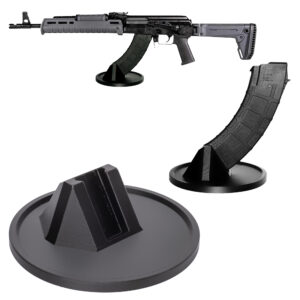
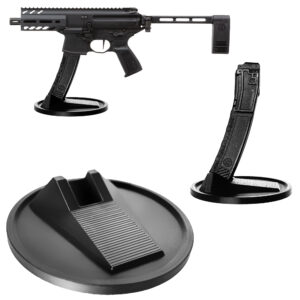
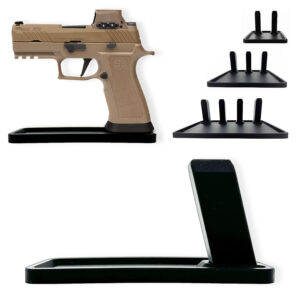


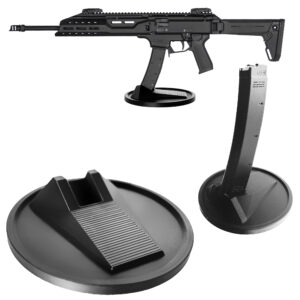
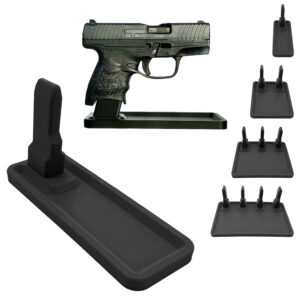

Colt
Colt M4 Carbine
Colt LE6920
Colt AR-15 A4
Daniel Defense
DDM4 V7
DDM4 V9
DDM4 V11
DDM4 ISR (Integrally Suppressed Rifle)
Smith & Wesson (S&W)
M&P15 Sport II
M&P15 Tactical
M&P15T
Bravo Company Manufacturing (BCM)
BCM Recce-16
BCM Recce-14
BCM MCMR Series
Aero Precision
M4E1 Series
AC-15
AR15 Pistol (Various Configurations)
Ruger
Ruger AR-556
Ruger SR-556
Ruger AR-556 MPR (Multi-Purpose Rifle)
Springfield Armory
Saint Victor
Saint Edge
Saint AR-15
PSA (Palmetto State Armory)
PSA PA-15
PSA AR-V
PSA Jakl (AR Pistol)
FN America
FN 15 Tactical Carbine
FN 15 Patrol
FN 15 DMR
Wilson Combat
Recon Tactical
Super Sniper
Protector Carbine
SIG Sauer
SIG M400 Tread
SIG M400 Elite
SIG M400 SDI
LWRC International
IC DI (Direct Impingement)
IC SPR
IC A5
Bushmaster Guns
XM-15 QRC
Bushmaster MOE
XM-15 Patrolman
Rock River Arms
LAR-15 Entry Tactical
LAR-15 Predator
LAR-15 Elite Comp
Stag Arms
Stag 15 Tactical
Stag 15L (Left-Handed Models)
Stag 15 Valkyrie
Noveske Rifleworks
Noveske Gen 4 N4
Noveske Space Invader (AR Pistol)
Noveske Recon
Anderson Manufacturing
AM-15 Optic Ready
AM-15 M4 Carbine
AM-15 Precision Rifle
Adams Arms
AA-15 Piston Rifle
P2 AARS (Adams Arms Rifle Series)
Black Rain Ordnance
SPEC15 Series
BRO Predator
Fallout 15
Diamondback Guns
DB15 Series
DB15CCMLB
DB15EB
Del-Ton Inc.
DTI-15
Del-Ton Echo 316H
Sierra 316M
Windham Weaponry
Windham SRC
Windham VEX-SS
Windham RMCS-4 (Caliber Conversion System)
Christensen Arms
CA-15 G2
CA-15 Recon
CA-15 Titanium Edition
Patriot Ordnance Factory (POF-USA)
Renegade Plus
P415 Edge
Revolution DI
LaRue Tactical
PredatAR
OBR (Optimized Battle Rifle)
LaRue Stealth 2.0
Battle Arms Development
Workhorse Patrol Carbine
BAD556-LW (Lightweight)
Authority Elite Rifle
Faxon Guns
Ascent AR-15
FX-19 (AR Pistol)
Streamline Ultralight Series
KE Arms
KE-15 SLT (Super Lightweight Tactical)
KE-15 Scout Carbine
Primary Weapons Systems (PWS)
MK1 MOD 2-M
MK116 PRO
MK107 (Piston AR Pistol)
ZEV Technologies
ZEV Core Elite Rifle
ZEV AR15 Billet Rifles
Franklin Armory
BFSIII AR-C1
Militia Model
F17-L (Chambered in .17 WSM)
Seekins Precision
SP15 DMR
NX15 Skeletonized Rifle
Havak Bravo
Aero Precision (Additional Models)
EPC-9 (Pistol Caliber ARs)
VG6 AR Rifles
Barrett Guns
REC7 DI
REC7 Gen II
CMMG
MK4 RCE
Resolute 300
Banshee (AR Pistol)
DPMS Panther Arms
Panther Oracle
Panther LR-308
H&K (Heckler & Koch)
HK MR556A1
HK416 (Military Variant)
Rock Island Armory (Armscor)
VR-80 Tactical AR (Shotgun AR Platform)
Troy Industries
Troy SPC-A3
Troy PAR (Pump Action AR)
Wilson Tactical
Tactical Recon AR
Protector Series
F1 Guns
FDR-15 Skeletonized Rifle
BDRx-15 Series
Juggernaut Tactical
JT-15
JT-10 Precision Rifle
AeroSurplus
Surplus AR-15 Rifles (Budget Models)
Thunder Tactical
AR-15 Basic Carbine
Tactical Builder Sets
Radical Guns
RF-15
Forged AR-Series
Dark Storm Industries
DS-15 Featureless Rifles
DS-10 Typhoon
DRD Tactical
Paratus
Aptus AR Rifles
Bear Creek Arsenal
BCA-15
AR Complete Upper Builds
Aero Survival Rifles (ASI)
ASR Tactical Series
Tactical Edge
WARFIGHTER Series
AR-15 Lightweight Rifles
Lone Star Armory
TX15 DMR
TX15 Carbine
HERA Arms
HERA H7
HERA AR-15 Lower Builds
IWI (Israeli Weapon Industries)
Zion-15
DRD Tactical
Tactical Modular Rifles
Quick-Takedown Rifles
V Seven Weapons
1776 Rifle
Hyperlite Rifle
Core Rifle Systems
Core15 Tac III
Core15 Patrol Rifle
Armalite (Original AR-15 Creator)
M15 Tactical
M15 A4 Carbine
DEF15 (Defensive Sporting Rifle Series)
PSA (Palmetto State Armory Additional Models)
PSAK-47 Hybrid (AR-AK Style Hybrid)
PSA Dagger (Pistol Caliber Configurations)
Odin Works
OTR-15
Odin Recon Rifle
Maxim Defense
MDX-508 PDX (Compact AR Pistol)
MDX-510 Rifle